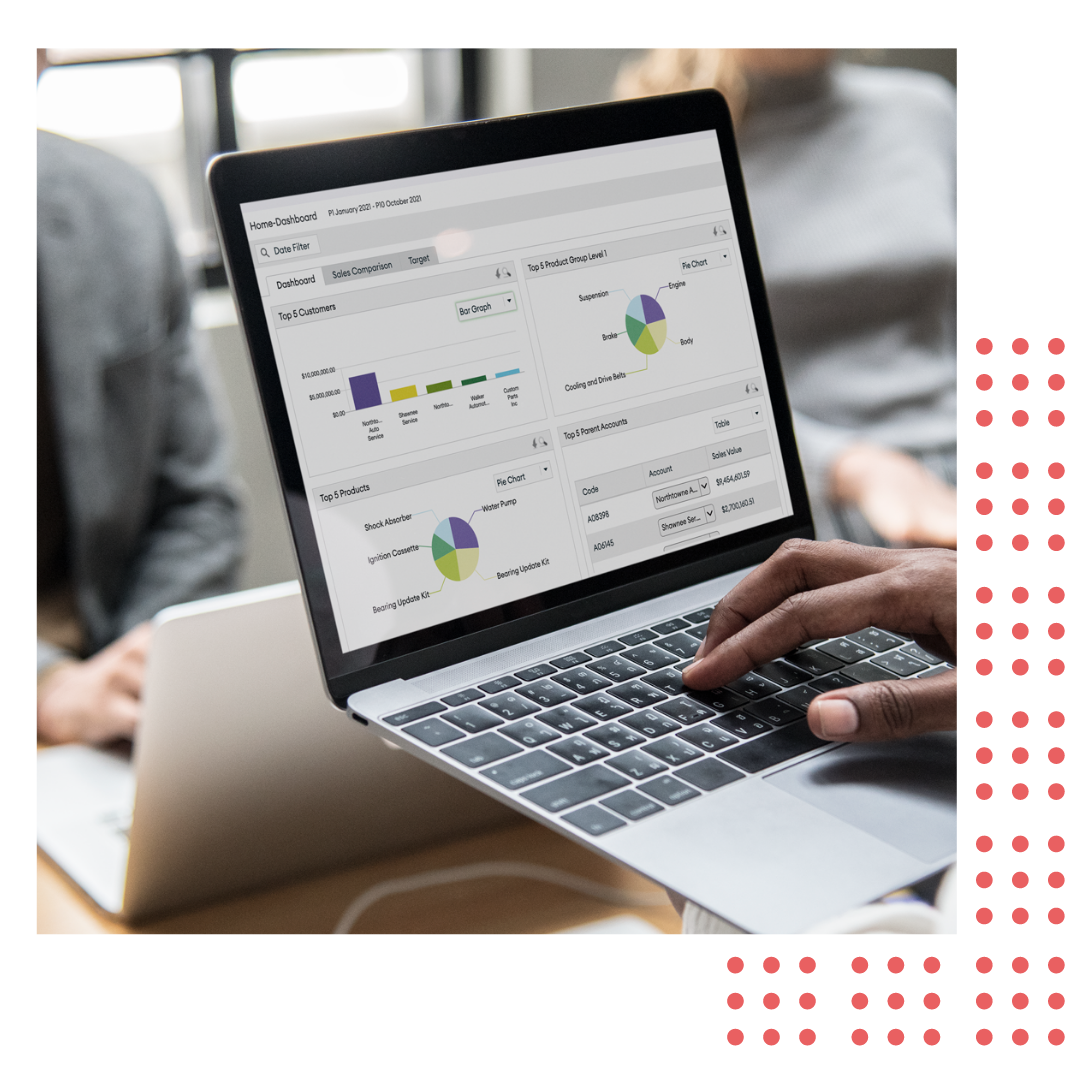%EF%B9%96width=1080&name=Sales%20analytics%20%E2%80%93Unlock%20your%20teams%20hidden%20power.%20(2).png)
Sales analytics –Unlock your team's hidden power.
Sales analytics – it might sound complicated, but could it be the key to enabling your reps and massively upping your sales?
Discover everything you need to know about sales analytics, including what it is and how it works, and why your business needs it.
Quick Links.
%EF%B9%96width=1080&name=What%20is%20sales%20analytics%20(1).png)
It might sound very daunting and like something straight out of an advanced maths lesson, but once you break it down, it’s no way near as complicated as it sounds.
Essentially, sales analytics is the process that’s used to identify and understand your sales and predict sales trends, based on all of your previous and existing sales data.
There’s lots of different data that sales analytics takes into consideration, but once you put this all together it can give you key information for forecasting future sales, and how to improve your overall sales.
Sales analytics and analytics tools and software can essentially act as your cheat sheet when it comes to creating a fool-proof sales strategy.
It provides you with valuable insights into your business and your sales activity so you can know about all of the ins and outs of all your sales and use that to make sure you’re putting your best foot forward.
%EF%B9%96width=1080&name=Fieldmobile%20sales%20enablement%20(8).png)
How does it work?
Sales analytics software looks at all of your sales data and helps to tie it all together.
Much like a jigsaw, sales analytics takes each individual puzzle piece of sales data and quickly slots them all together to give you the overall picture in a clear and simple way.
The software will look into all of your current ‘back end system data’, and grab all of the information it needs to pull together an efficient dashboard, or report.
It works to break down what can be very complicated data and spins it around into actionable insights on the things your team are doing that are great, and the things you can improve on too.
What is sales data?
Sales data is what feeds sales analytics – it’s the nitty-gritty stuff that lies at the heart of your sales team activity, and really unearths all the important information. You can unearth everything you need to know. You can dig into your sales data to get what you need to understand your team’s performance, retain existing customers, and spot new opportunities.

Types of sales data
There are different types of data you have access to in your business, but loosely speaking, if your data is measuring something about sales; it’s sales data.
Sales data is made up of an array of metrics too, and depending on your business and what you really want to get out of your sales analysis, some will be more useful to you than others.
From demographic data about where your customers are based, to firmographic data on the type of customers you have, there are lots of different ways you can dig into your sales data to get what you need.
Which sales data metrics are right for me?
All of that data can be overwhelming, but in general, these 6 different types of sales data metrics are a great foundation of sales analytics.
View the different types of sales data ↓

Sales by region
Looking at your sales by region will tell you key information about which locations are great for your business, and which ones aren’t performing as well. You can discover when and what products are selling in certain areas, and you’ll also be able to spot any geographical trends in your sales.
%EF%B9%96width=80&height=80&name=Sales%20by%20rep%20(1).png)
Sales by rep
Looking at the number of sales by each rep might seem like an obvious metric, but it’s important, nonetheless. Remember though, to get a full picture of your sales team, it’s crucial to not just look at the number of sales, but also the value of each sale too.

Sales targets
Looking into your sales targets as one of your key metrics is important to understand and evaluate your business's long-term goals. By monitoring your sales targets each month, you’ll get to evaluate where you are in terms of the bigger, yearly goals.

Sales growth
Your sales growth shows you how much your revenue increases and decreases over any specific period of time. This is a key part of sales analytics and will provide you with an over-arching view of how your sales team are performing.

Sales per product
Sometimes called product performance, sales per product shows you the amount of profit each product will bring you. Much like with sales per rep, it’s important not to just look at the upfront cost of a product, but also the frequency at which that product is brought too.

Average purchase value
Your average purchase value tells you the average price of each sale you make, and the average amount that customers are spending with you on each purchase. It’s a helpful metric to use when it comes to sales targets and forecasts, and you’ll be able to use it when looking at ways to boost your revenue.
%EF%B9%96width=1080&name=Why%20does%20your%20business%20need%20sales%20analytics%20software%20(1).png)
Our sales analytics tool will do a deep dive into your data and give you a helpful report that tells you everything you need to know about your sales.
Once you can peek under the hood of your sales, your team will be more empowered than ever before.
Picture it like a hidden gold mine full of data – you’ll get to discover everything you need to fully maximize your team, and really get to the bottom of what makes your sales tick.
One of the biggest draws to sales analytics software is the fact that it can massively increase and impact your overall sales – after all.
Once you figure out what’s working and what isn’t, you’ll be able to entirely focus on the good stuff.
%EF%B9%96width=1080&name=What%20is%20sales%20enablement%20and%20why%20should%20I%20care%20(1).png)
While sales data analytics can’t quite go out and actually sell your products, it can show you the good, the bad, and everything in between.
To gain that competitive edge, you can use data analytics to increase sales by drilling down into the data and learn everything about your sales.
Sales data analytics helps you to fully get to grips with your sales and understand all of the factors that are influencing them, and from there you can pinpoint exactly what’s working and what isn’t.
By being able to pinpoint what’s working for you, you can narrow it down to certain factors, whether that be a certain product or a particular rep, and this allows you to replicate your previous success.
Sales analytics will essentially give you the formula to go from, for what works, and what doesn’t work.
What are the benefits of sales analytics?
The power of sales analytics can be huge when used right, and there are plenty of benefits to implementing a proper sales analytics system. As the system monitors and evaluates your sales data, it also highlights the great things salespeople are doing, and the things that aren’t quite right.
%EF%B9%96width=80&height=80&name=Better%20understand%20your%20customers%20(1).png)
Better understand your customers
Have you ever just wanted to really get inside a customer’s mind and figure out exactly what they’re thinking? Sadly, sales analytics isn’t quite at the telepathic stage yet, but it’s the next best thing. Sales data analytics will tell you all about your customer's buying behaviors and patterns, so you can see an overview of any trends.
%EF%B9%96width=80&height=80&name=Clear%20overview%20of%20your%20sales%20(1).png)
Clear overview of your sales
Forget the endless spreadsheets and spending days deep-diving into your sales data - a sales analytics tool will do all the hard work for you. Not only do you get a better insight into your customers, but you’ll also have a full overview of all of your sales.

Knowing your most profitable customers & products
Whilst profitable doesn’t always mean best, it never hurts to know who, and what is bringing in the most revenue for you. Sales analytics tells you which customers are buying the most, and which product is selling the most, allowing you to look at new ways of engaging your big spenders, and new ways to sell your best performing product.

Understanding what’s working, and what isn’t
Ever had a month that saw a huge increase in your revenue, but you just couldn’t figure out why? Sales analytics tells you exactly what you’re doing well, from your best performing rep to the most successful marketing campaign and channel, and it also tells you what didn’t quite hit the target too, so you can learn how to replicate your wins.
Who can use sales analytics
Sales analytics isn’t exclusive to any particular sector or type of company; anyone and everyone has something to gain from the right software.

Sales analytics can be used within sales teams of all shapes and sizes, and all salespeople and reps can benefit from gaining insight.
Sales managers can use this data and report to focus on any coaching or training that might be needed and can use the data to better predict forecasts and trends.
Sales reps and salespeople find sales analytics incredibly helpful, from learning which products are performing the best to which geographical locations to focus in on.
You could even see when a customer's spend is dropping off so you can quickly nip that in the bud and save your customer.

How to present sales data
First things first, you’ll want to make sure that your data is clear, easy to understand, and has all of the relevant information.
When your data is confused and muddled, it can be difficult to see any real value to the data, and difficult for you to understand what it’s trying to tell you.
It’s also important to make sure it’s easy for all of your sales team and reps to understand and use, and that it’s all kept somewhere they can easily access whenever they need to.
Through using a sales analytics tool, the software will automatically turn your data around into something easy and simple to understand, so the only thing you need to worry about is what to do next.
“The sales team is more productive as they are not spending hours of valuable time on spreadsheets.”
Tony Phelps
Sales and Marketing Manager at Helapet
Interested? Book a demo or get in touch!
Find out how we can give you the insight you need to plan your sales pipeline more efficiently, find more easy-to-close opportunities, and boost customer loyalty.






